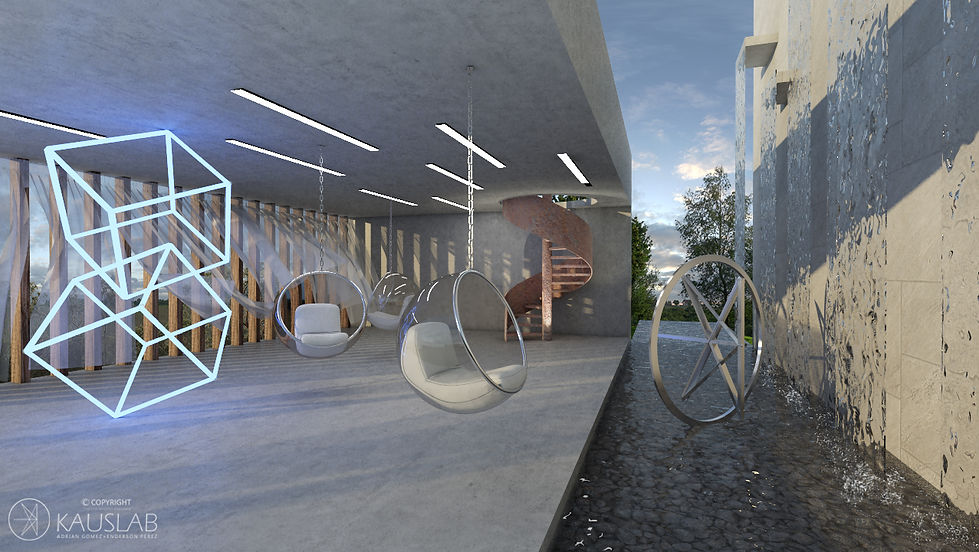MAGAZINE - KAUS UNIVERSE
M-KU

EL SONIDO
COMO VIBRAN LOS ESPACIOS
SERIE EL DISEÑO Y LOS SENTIDOS
¿Cómo se percibe la arquitectura sin observarla? ¿Cómo determinar las dimensiones de un espacio sin medirlo? El secreto está en vibrar con ese espacio y con los sonidos que allí se emiten, incluso si es nuestra propia voz la que resuena, está subestimado el poder de un espacio acústicamente acondicionado, dependiendo de su función y su estructura, encontramos cierta comodidad y armonía en espacios donde el sonido resuena sin convertirse en ese ruido molesto que no sabemos de dónde viene.
Bajo este concepto, imaginemos habitaciones donde podamos conseguir ese agradable silencio al final del día, o donde nuestra música suene a todo volumen sin dañar nuestros oídos ¿Cómo sonaría nuestra casa ideal? Nuestra cocina, sala, comedor, habitaciones, todo pensado en generar esa atmosfera única y especial que cada área debe tener, y que solo se logra a través de una buena acústica, de imaginar las situaciones que pueden darse en ese lugar y de diseñar y estructurar en base a eso.
Así como se piensan los teatros, las conchas acústicas al aire libre, las catedrales y monasterios, así mismo deben pensarse las distintas áreas de una casa, de un salón de clases o hasta de un centro comercial, teniendo en cuenta cuántos sonidos se reproducirán ahí, y cómo éstos podrían afectar las sensaciones que experimenten las personas al percibir y vivir esos espacios, teniendo en cuenta que cada sonido emitido, es una vibración que interviene la estructura y que, de no tener esto claro, puede generarse una atmósfera de caos y ruido, pudiendo hacer de esta una experiencia desagradable, aunque lo que percibamos con otros sentidos sea armónico.
Es entonces donde queda claro que la arquitectura es un arte que se percibe de forma vívida, es una experiencia, más que una obra plástica, o una escultura habitable que se yergue a gran escala, que es percibida por todo nuestro cuerpo, hasta el punto en que vibramos con ella. Si, somos capaces de vibrar con toda una gigantesca estructura a través de los sonidos, de ahí que los cantos de los monjes pueden elevarlos a niveles sublimes de conciencia, porque resuenan con toda una estructura, un templo completo pensado en pro de esa resonancia, de los sonidos y de la vibración que éstos buscan en un espacio donde el objetivo principal es elevarse, en todo el sentido dela palabra.
Por suerte hay una infinidad de recursos a nuestro alrededor para mejorar el sonido en nuestros espacios, desde alfombras en lugares muy ruidosos, hasta cortinas y persianas que permean disonancias, muebles que funcionan como cajas acústicas; todo es cuestión de despertar la conciencia en nuestros espacios, lo que nos molesta, eso que nos hace ruido y no sabe qué es, probablemente sea un sonido disonante. Solo así, podremos acertar en ese “estar” placentero que se busca; es, sin duda, la afirmación de que nuestros espacios vibran con nosotros y nosotros con ellos, y con todo.
THE SOUND
HOW THE SPACES VIBRATE
SERIES THE DESIGN AND SENSES
How is architecture perceived without observing it? How to determine the dimensions of a space without measuring it? The secret is to vibrate with the space and the sounds that are emitted there, even if it’s our own voice that resonates, the power of an acoustically conditioned space is underestimated, depending on its function and its structure, we find some comfort and harmony In spaces where the sound resonates without that annoying noise that we do not know where it comes from.
Under this concept, imagine rooms where we can get that nice silence at the end of the day, or where our music sounds at full volume without damaging our ears, How would our dream house sound? Our kitchen, living room, dining room, rooms, all thought to generate that unique and special atmosphere that each area must have, and that is only achieved through a good acoustics, to imagine the situations that can occur in that place and to design and Structure based on that.
Just as the theaters, outdoor acoustic shells, cathedrals and monasteries are thought of, the different areas of a house, a classroom or even a shopping center should be noticed, considering how many sounds will be reproduced there , And how these could affect the sensations that people experience when perceiving and living those spaces, taking into account that each sound emitted, is a vibration that intervenes the structure and that, if this is not clear, an atmosphere of chaos can be generated and Noise, and can make this an unpleasant experience, even if what we perceive with other senses is harmonic.
It’s clear that architecture is an art that is perceived in a vivid way, is an experience, more than a plastic work, or a habitable sculpture that stands on a large scale, which is perceived throughout our body, to the point In which we vibrate with it. Yes, we are able to vibrate with a whole gigantic structure through the sounds, hence the songs of the monks can elevate them to sublime levels of consciousness, because they resonate with a whole structure, a whole temple thought for that resonance, The sounds and the vibration that they seek in a space where the main objective is to rise, in the whole sense of the word.
Fortunately, there is an infinite number of resources around us to improve the sound in our spaces, from carpets in very noisy places, to curtains and blinds that permeate dissonance, furniture that works as acoustic boxes; Everything is a matter of awakening the consciousness in our spaces, which bothers us, that makes us noise and does not know what is probably a dissonant sound. Only in this way, can we succeed in that pleasant "being" that is sought; Is, without a doubt, the affirmation that our spaces vibrate with us and us with them, and with everything.
Texto: KAUSLAB
Publicado: 24-06-2017